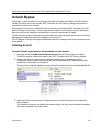
RealPresence Collaboration Server (RMX) 1500/1800/2000/4000 Administrator’s Guide
Polycom®, Inc. 739
The order of the Auditor File Viewer field header columns can be changed and the fields can be
sorted and filtered to facilitate different analysis methods.
2 In the event list, click the events or use the keyboard’s Up-arrow and Down-arrow keys to display
the Request Transaction and Response Transaction XML trees for each audit event.
The transaction XML trees can be expanded and collapsed by clicking the expand
( ) and collapse ( ) buttons.
To open an auditor event file stored on the workstation:
1 Click the Local File button ( ) to open the Open dialogue box.
2 Navigate to the folder on the workstation that contains the audit event file.
3 Select the audit event file to be opened.
4 Click Open.
The selected file is opened in the Auditor Viewer.
IP Address (Workstation) The IP address of the workstation used to send the request that triggered the
event.
Event Type Auditor events can be triggered by:
• API
• HTTP
• Collaboration Server Internal Event
Event The process, action, request or transaction that was performed or rejected.
• POST:SET transactions (API)
• Configuration changes via XML (API)
• Login/Logout (API)
• GET (HTTP)
• PUT (HTTP)
• MKDIR (HTTP)
• RMDIR (HTTP)
• Startup (Collaboration Server Internal Event)
• Shutdown (Collaboration Server Internal Event)
• Reset (Collaboration Server Internal Event)
• Enter Diagnostic Mode (Collaboration Server Internal Event)
• IP address changes via USB (Collaboration Server Internal Event)
Process Completed Status of the process, action, request or transaction returned by the system:
• Yes – performed by the system.
• No – rejected by the system.
Description A text string describing the process, action, request or transaction.
Additional Information An optional text string describing the process, action, request or transaction in
additional detail.
Auditor Event Columns (Continued)
Field Description


















